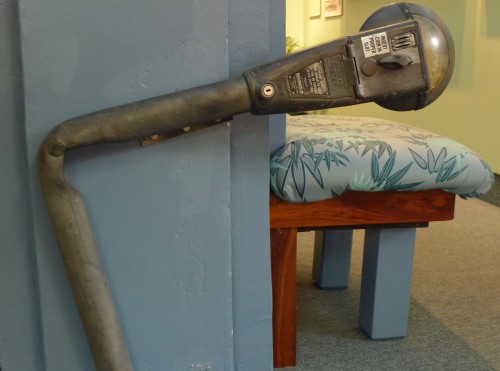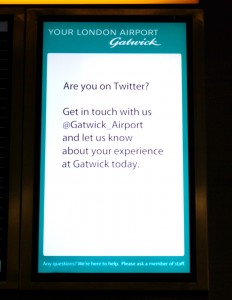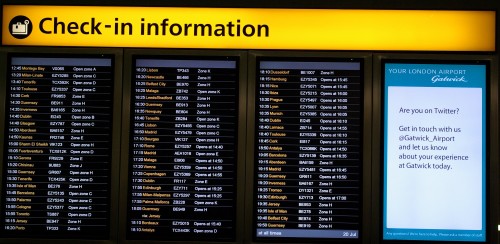
From the Pacific Tsunami Museum in Hilo, Hawaii
If you happened to be on the road – in a hotel, a convention center or, of course, in an airport – when some sort of disaster strikes, would you know what to do? And would you have the right tools and supplies with you so that you could do what you needed to do?
I wasn’t confident I would.
But after talking with experts and savvy travelers about the ideal contents of an emergency ‘go kit’ for this story on msnbc.com – Disasters prompt world travelers to be prepared – I’m feeling more confident about dealing with everything from tsunamis to zombies when I’m on the road.
Here’s the story:
When an 8.8-magnitude earthquake struck Chile at around 3:30 a.m. in February 2010, Seattle-based wine importer Ryan Sytsma was asleep in a Sheraton hotel somewhere between the airport and downtown Santiago.
Once he realized it wasn’t a train shaking the room, Sytsma jumped out of bed and stood in the bathroom doorway.
“It kept getting worse,” he said. “Soon the electrical outlets started throwing sparks, anything unsecured was falling over and smoke filled the room. I could only see flashes of light, hear explosions like bombs and smell smoke that was a mix of drywall dust, burning plastic and melting rubber.”
Sytsma survived the three-minute temblor unscathed and raced out of his hotel room with his passport, cash, shoes and his small suitcase, which was already packed and near the door.
Those items, and the extra shirts and dozen Power Bars packed in the suitcase, helped ease the post-earthquake experience a bit for Sytsma and the people he ended up with. And now Sytsma makes sure to pack for every trip with disaster preparedness in mind.
Good idea, say the experts. A well-stocked emergency “go kit” can arm a traveler with tools that may help keep a bad travel situation from turning into a full-blown disaster.
“Given the recent events in Japan, Egypt and other places that appeared as low to insignificant on the risk map last year, a lot of people are rethinking their preparedness,” said Alex Puig, regional security director for International SOS, a global medical and security assistance company. “We’re not asking people to go above and beyond what common sense dictates. But anything can happen, and preparation is the most important thing you can do.”
Be prepared
Snow, rain or even a computer glitch, as Alaska/Horizon passengers learned this past weekend, may delay your plane for hours or days. You may get stung by a jellyfish, mugged by thug or knocked unconscious by a falling coconut. Then there are earthquakes, floods, tornadoes, hurricanes, pandemics or political upheaval to deal with.
Of course, many travelers will never experience an emergency while on the road. And danger can also find you close to home.
But for those who want to be prepared, what should go in an emergency kit?
“A good police whistle, two glow sticks, a small roll of wide adhesive tape to prevent hotel doors from closing, and $100 in local currency in small denominations,” said Noel Koch, senior director of travel intelligence for the travel risk management company NC4.
Koch considers a smartphone, with a reliable service provider, essential as well. “In the case of Japan, a smartphone would have given the traveler the ability to get information on how to book a flight out of Tokyo,” he said. “In the case of Egypt, travelers could have gotten information via Twitter to find out what was happening with the protests.”
Medications, both prescribed and over-the-counter, belong in your kit as well. “Take enough for your trip and an extra supply in case you get delayed or stuck someplace for a certain length of time,” said Myles Druckman, vice-president of medical services for International SOS. “You can’t assume you’ll be able to find the same medications you have at home. And some over-the-counter medicines may be prepared or branded differently than you’re used to at home.”
Puig adds that you go should always have items that allow you to travel and communicate. That includes a copy of your passport (with another copy saved in e-mail or another electronically accessible way), a cell phone you know will work in any country you’re visiting and a calling card to use if your cell phone dies or is stolen. “None of that really requires a lot of extra effort,” he said.
Make room for these items
Beyond the basics, you may want to add some of these items to your “go kit.”
Beth Whitman, founder of Wanderlust and Lipstick, used to carry a water purifier only on her international trips. “Now I won’t leave home without it even to a destination with drinkable tap water because I realize it would be perfect if water supplies were compromised,” said Whitman.
When she travels to West Africa, nature writer Susan McGrath takes a folding mosquito tent and beeswax earplugs in case she finds herself in a village with a community loudspeaker that plays bad pop music 24/7. She also always takes along a headlamp. “I did get stranded in Nigeria during a countrywide shut down and lived briefly in the Lagos Hilton on my emergency kit,” said McGrath. “And when the power went off in the very crowded airport at 11 p.m., I was pretty well equipped not to panic.”
When WanderingEducators.com publisher Jessica Voights travels with her wheelchair, her “go kit” includes the phone number and address of a mobility organization or store that can help in case of an emergency and/or equipment failure, extra batteries, adapters and converters for medical devices, extra copies of prescriptions “and letters from doctors explaining my medical conditions and equipment needs.”
And Suzanne Rowan Kelleher, editor of WeJustGotBack.com, keeps a few quart- and gallon-size Ziploc bags in her “go kit” as well as “phone numbers and policy numbers for my car and health insurance, customer service numbers for credit cards and contact numbers for my family’s doctors and pediatrician.”
Pre-packed kits and emergency quarters
At minimus.biz, which sells a wide variety of travel and trial-size items, miniature rolls of duct tape, individual packets of water purifier and glow sticks are listed under the “Survival” tab. Pre-packaged “personal care” kits filled with three days’ worth of water, food and other basics supplies are there, too. Company co-founder Paul Shrater said that since the Japanese disaster, he’s gotten a lot of inquiries from companies and agencies seeking to stock up on those emergency kits but few calls from vacationers seeking to create their own travel-versions of the kits.
“If you really stock it correctly and think of all the things you really need, you start getting up there in terms of weight and size,” said Shrater.
That’s why Puig of International SOS urges worried travelers to sit down and make a plan. “Do an analysis of who you are, how you travel and what the risks are in the country you’ll be traveling to,” Puig said. “Ask yourself how well prepared you’d be if you were in Cairo when the demonstrations broke out or in Japan after the earthquake. What are the things you’d need to have to be prepared?”
Mitch Ahern of technology consulting firm Cantina is prepared. He carries a roll of quarters in his travel emergency kit for late nights at airports or trade show set-ups when dinner may come from a vending machine. Ahern said the quarters have a dual purpose. “I have it on excellent authority that a roll of quarters in a sock makes an excellent zombie-stopper when applied with force to the head!”







